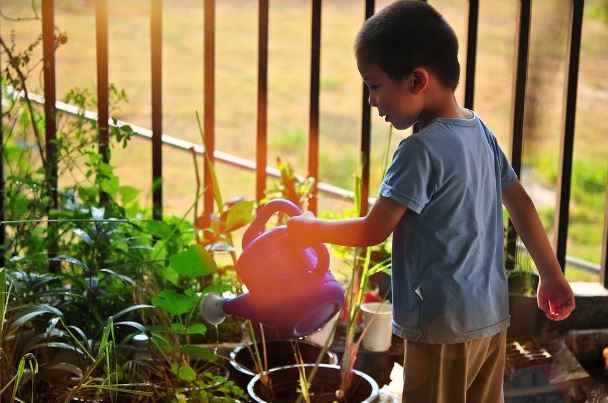5 Easy Ways to Cultivate Your Child’s Green Thumb

5 Easy Ways to Cultivate Your Child's Green Thumb
By Francis Black
Teaching kids to garden is a great way for families to spend together time. But that’s
just the beginning of the benefits. Gardening reinforces a child’s appreciation of the
outdoors and encourages a lifelong habit of environmental stewardship. It teaches
patience and fosters a sense of responsibility and competence. Digging in the dirt also
gives them a hands-on education in botany, chemistry, and math. And for the littlest
gardeners, the tasks of digging and planting help strengthen fine motor skills.
The long-term health benefits of teaching a child to grow fruits and vegetables is so
important, the American Heart Association has established more than 500 teaching
gardens at our nation’s schools in the past decade. But the grandest and easiest way to
garden with kids is in your own backyard. This way, the whole family can enjoy the
benefits of growing their own food while enhancing the beauty of their landscaping.
It doesn’t have to be difficult or time-consuming. Here are five easy ways to cultivate
your child’s green thumb.
1. Start Small
The beginning can be as simple as planting tomato seedlings in a patio pot or sunflower
seeds in a cup and placing them in a sunny window. If planting outdoors, a child’s
garden should have clear paths for easy access and beds that are narrow enough for
the kiddo to reach across.
2. Choose Interesting Plants
Edible plants are a must. These can be as simple as a few vines of sweet snacking
tomatoes or as full-blown as a themed pizza garden of tomatoes, peppers, and basil.
Don’t forget to add some color with easy-to-grow annual flowers such as petunias and
marigolds. Add extra educational and aesthetic value by including native plants that are
beautiful, easy to grow, and well-suited to Phoenix’s arid environment. They’re also eco-
friendly since they require little water and attract native wildlife.
3. Purchase Good Tools
Colorful child-sized tools will entice your child and be easy to use. But, as with your own
tools, don’t overlook quality. You want shovels, trowels, and rakes as durable as they
are attractive. Don’t forget to include a pair of sturdy gardening gloves and a wide-
brimmed hat that can protect them against the strong Southwestern sun.
4. Be Consistent
Set aside 15 to 20 minutes a couple of times a week to pull weeds, water plants, and
note the garden’s progress. Some young gardeners will enjoy — and benefit from —
making charts or graphs of weekly changes. At the end of each garden session, make
sure your child puts away all tools, hoses, and watering cans.
5. Celebrate the Bounty
Whether it’s harvesting blooms from a flower garden that features every color of the
rainbow or preparing a meal with your child that includes the edible plants you’ve
chosen, make time to honor a job well done. The gesture can be as simple or as
complicated as your time and garden permits.
Think of the joy they'll get from serving freshly harvested berries in the morning to
inviting friends over for a celebration dinner featuring homegrown fruits and vegetables.
An added bonus? Gardening is an excellent way to get even the pickiest eater to eat
their veggies!
To find out what webinars or live classes are available for free click here!
Francis Black is a former real estate agent who now stages homes for resale. She’s an avid do-it-yourselfer who likes to refurbish old lawn furniture and grow her own fruits and vegetables.
For image source click here.

